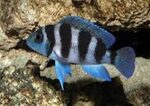Bristle Nose Catfish Common 4cm originate from rivers and flood- plains throughout the Amazon River. They generally inhabit areas of fast flowing water.Bristlenose originate from water that is slightly acid and soft but are quite tolerant to a wide range of wa- ter qualities. These catfish are peaceful and will mix with just about any fish from Neon Tetra’s to African cichlids.
Difficulty: Easy
- Max Growth Size:15 cm
- Temperament: Peaceful
- Preferred Water Parameters:
- Temperature: 23-27 degrees celsius
- pH Level: 6.5—7.5
- Range: Amazon region
- Diet: vegetarian to omnivorous and require vegetable matter in their diet. Sinking tablets, wafers or pellets containing Spirulina or similar are ideal. Bristlenose catfish also readily feed on vegetables such as squashed peas, cucumber, zucchini, pump- kinandlettuce.They have a‘sucker mouth’with rasping teeth that are ideal for eating algae etc off surfaces
Bristle Nose Catfish Common 4cm are also reasonably tolerant of water quality and can adjust to most water conditions that are close to their own. Mature males may be aggressive to other males but in general this species is an ideal community fish, and in fact one of the most popular community tank catfish.
Colour and Varieties Bristlenose catfish are generally a dark brown/grey colour with small, paler spots across the body. Several colour varieties have been selectively bred including albino and marble colour forms. There are also long finned varieties available
SexingSexually mature males develop branched, short bris- tles extending from their, Females generally do not develop bristles and if they do are considerably smaller than the males. Mature females can also be readily identified by a rounder stomach than males, this is very obvious when looking down onto the catfish.
General InformationBristlenose catfish are great addition to any tank and are highly recommended for any tropical community tank, where they help in keeping the inside of tanks clean by eating algae off all surfaces. They will tend to hide during the day amongst plants or under rocks etc but become more active at night when they feed.
They should be provided with hiding places in the form of caves,hollow logs etc.Pairs will often spawn if well maintained in community tanks and provided with hiding places. Bristlenose like flowing water and the addition of a powerhead is often beneficial for this species.




.jpg)




.jpg)